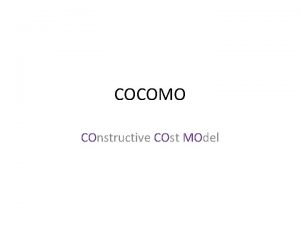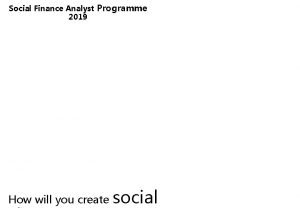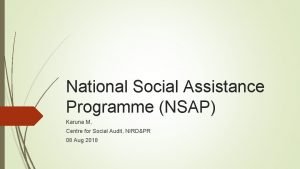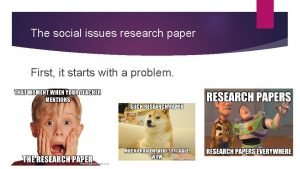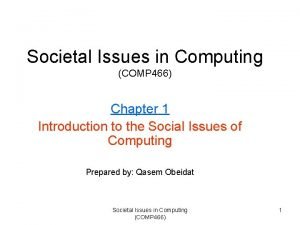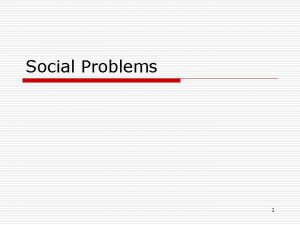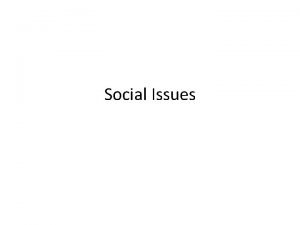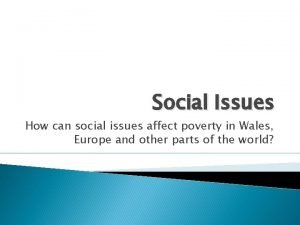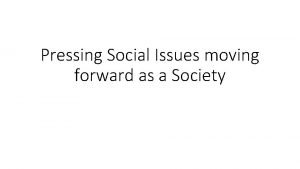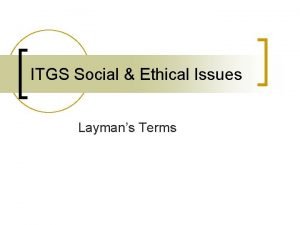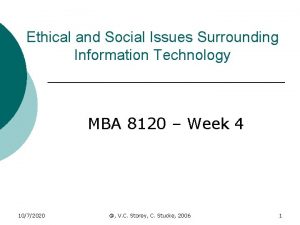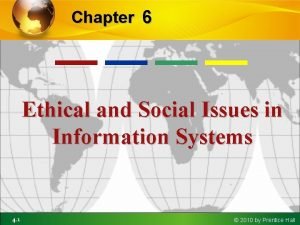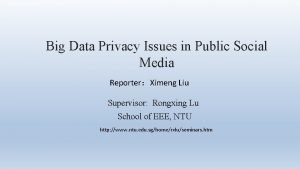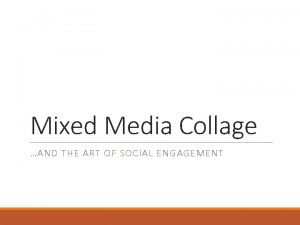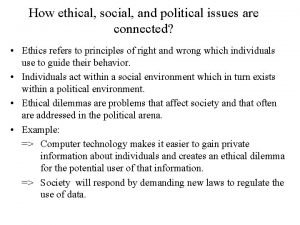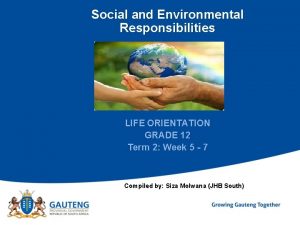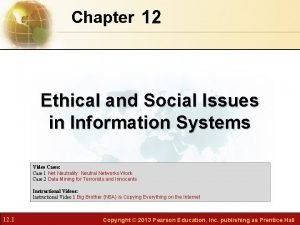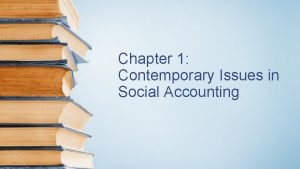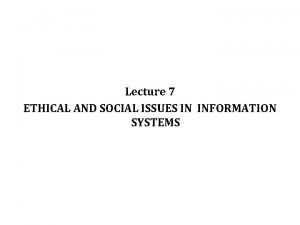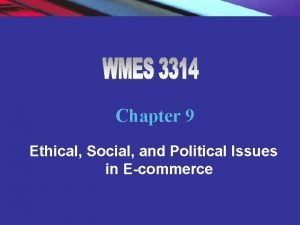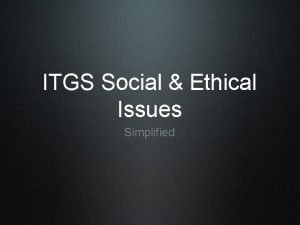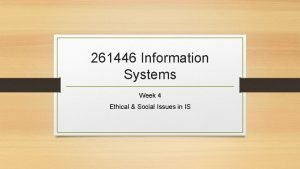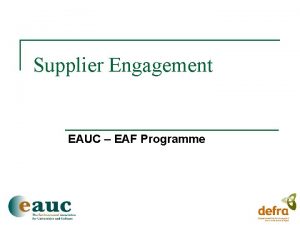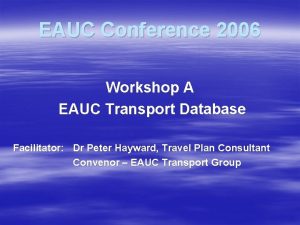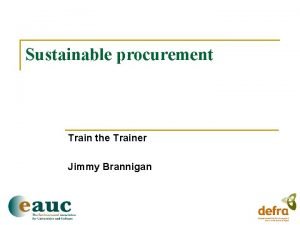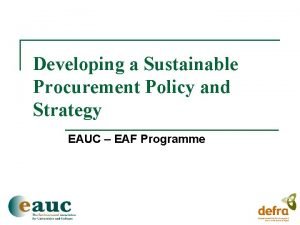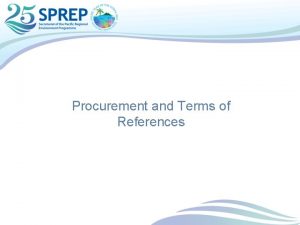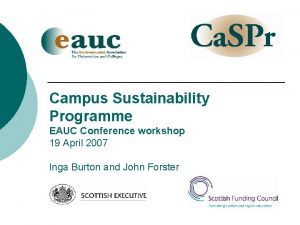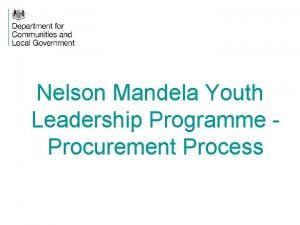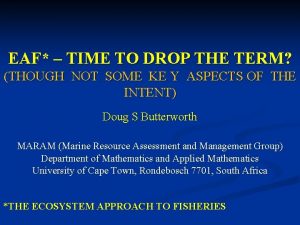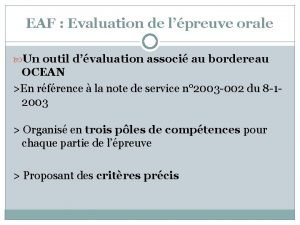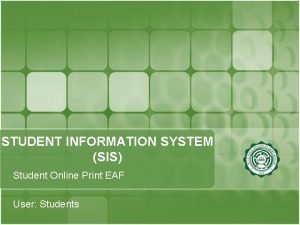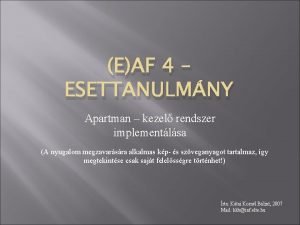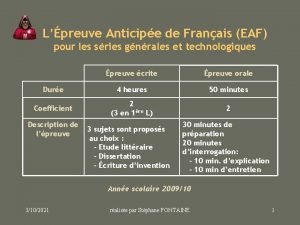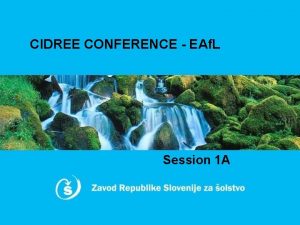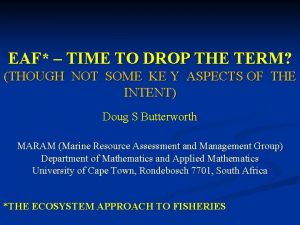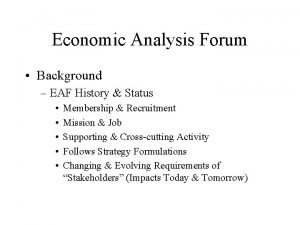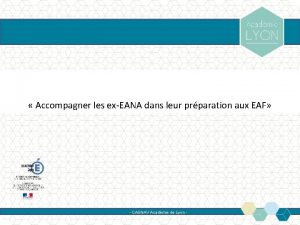Social Issues in Procurement EAUC EAF Programme EAF
































- Slides: 32

Social Issues in Procurement EAUC – EAF Programme

EAF Programme n Background q q Three year project Reducing negative environmental and social impacts through purchasing Steering group, partners from Further Education and Higher Education Training n Train the trainer n Policy and strategy development n Risk based approach to procurement n Supplier engagement n Social issues in procurement

Social Issues in Procurement Agenda 13. 00 13. 20 14. 00 14. 30 14. 45 15. 30 16. 15 16. 30 Introductions and objectives What do we mean by social issues? What guidance exists? Coffee What does good practice look like? Case Study Review Where do I start? Action Planning Close

Social Issues in Procurement n Format and style of workshops q q Interactive Informal Varied Proactive

Social Issues in Procurement Objectives n n n Develop a shared understanding of what we mean by ‘social issues in procurement’ Review good practice – Novo Nordisk Identify opportunities to build social issues into your procurement activity

What do we mean by social issues? Come up with a list of social issues

Social Issues in Procurement n CIPS publication ‘Develop Ethical Purchasing Practices’ identified the following q q q q q Forced labour Employment relationships Freedom of association Wages and working hours Treatment of employees Law Health and Safety Child labour Discrimination

Social Issues in Procurement n As early as 1992 B&Q developed a social policy – they identified the following specific issues q q q q q The exploitation of child labour Bonded labour – including prison camps Health and Safety Cottage industry Migrant workers Fair wages / living wage Freedom of association Equal opportunities Discrimination Bullying

Social Issues in Procurement n Vodaphone Code of Ethical Purchasing q q q q q Child labour Forced labour Health and Safety Freedom of Association Discrimination Disciplinary Practices Working Hours Payment Individual Conduct Environment

Social Issues in Procurement n Where is it drawn from? q q 1948 the General Assembly of the United Nations adopted and proclaimed the Universal Declaration of Human Rights 30 Articles identifying basic human rights to be adopted by member states

Social Issues in Procurement n Core Conventions of the International Labour Organisation q q Eight ILO Conventions have been identified by the ILO's Governing Body as being fundamental to the rights of human beings at work, irrespective of levels of development of individual member states. These rights are a precondition for all the others in that they provide for the necessary implements to strive freely for the improvement of individual and collective conditions of work

Social Issues in Procurement n Freedom of association q q n Freedom of Association and Protection of the Right to Organize Convention, 1948 (No. 87) Right to Organize and Collective Bargaining Convention, 1949 (No. 98) The abolition of forced labour q q Forced Labour Convention, 1930 (No. 29) Abolition of Forced Labour Convention, 1957 (No. 105)

Social Issues in Procurement n Equality q q n Discrimination (Employment and Occupation) Convention, 1958 (No. 111) Equal Remuneration Convention, 1951 (No. 100) The elimination of child labour q q Minimum Age Convention, 1973 (No. 138) Worst Forms of Child Labour Convention, 1999 (No. 182)

Social Issues in Procurement n The CIPS position on Ethical Business Practices in Purchasing and Supply Management distils aspects of current developments in the area, including: q q The Ethical Trading Initiative (ETI) Base Code The Core Convention of the ILO The UN Declaration on Human Rights SA 8000 (a Social Responsibility Standard developed by the Council on Economic Priorities Accreditation Agency in New York - now known as Social Accountability International (SAI)

Social Issues in Procurement n What does all this mean? q q General consistency when people talk about social issues The issues identified are well known and drawn from the same sources Whilst well developed in certain sectors still ignored in many places Rhetoric tends to focus on the global challenges rather than the local opportunities

What guidance exists?

What guidance exists? n OGC / Defra joint note on environmental issues in purchasing – Social issues in procurement n Interpretative Communication on integrating social considerations into public procurement - frequently asked questions

What guidance exists? n Develop Ethical Purchasing Practice, 2001 – CIPS n The ethical decision – An executive guide to corporate social responsibility, 2004 – CIPS n Social issues in purchasing, February 2006 – Office of Government Commerce

What does it say? n Opportunities exist at different stages of the procurement process and can legitimately be incorporated into your activities

What does it say? Identifying the need Contract management The specification A simplified approach Tender evaluation Supplier Selection

What does it say? n But remember: q q q They must be relevant to the subject matter of the contract Actions must be consistent with the EU Treaty and the EU Public Procurement Directive Most progress can be made if social issues are considered at the earliest stages of the procurement cycle

Novo Nordisk Case Study

Novo Nordisk n Read the materials provided? q q q What do you like about their approach? Is any of it relevant to your institution? What can you apply to your situation?

Where do I start?

Where do I start? n n Are social issues identified in your current purchasing strategy or policy? Are social issues identified as a priority by any other part of the business? Have obligations relating to social legislation been considered? Could you take a risk based approach to identify high spend / risk areas?

What social issues are important to your institution? Produce a list that you think is relevant and useful to you

Where do I start? n n n Consider social issues from the outset, there is most scope early on in the process Carefully plan the procurement process to ensure it is accessible to a suitable variety of suppliers Use performance or functional specifications where appropriate for desired social outcomes to encourage innovative solutions Assemble relevant expertise procurement specialists and end users Early dialogue with the supplier community – tell them what is important to you.

Where do I start? n Here a number of important social issues that might be relevant to your institution. q q q q q Community Benefits Core Labour Standards Disability Equality Employment and Training Issues Fair Trade Gender Equality Race Equality Including Small and Medium Sized Enterprises Work Force Skills

Exercise As a contracting organisation what actions could you take?

Action Planning n Realistically q q q What can you take forward? How will go about it? SMART

Summary n n A complicated and developing area Starting point is the same as with environmental issues q q q n n What's important to you? What are the risks? What can you realistically do? Focus on small steps close to home Guidance and further support is available

Many thanks jbrannigan@esdconsulting. co. uk www. eauc. org. uk
 Intermediate cocomo model example
Intermediate cocomo model example Eaf 228
Eaf 228 Fmu eaf
Fmu eaf Social thinking social influence social relations
Social thinking social influence social relations Social thinking social influence social relations
Social thinking social influence social relations Social finance analyst programme
Social finance analyst programme Karuna social programme
Karuna social programme Social issues for research paper
Social issues for research paper Social issues in computing
Social issues in computing Defining social problems
Defining social problems Social issues meaning
Social issues meaning Social issue examples
Social issue examples Pressing social issues
Pressing social issues Ethical and professional issues in information security
Ethical and professional issues in information security Itgs social and ethical issues
Itgs social and ethical issues Issues surrounding information privacy
Issues surrounding information privacy Social and ethical issues in information systems
Social and ethical issues in information systems Learning english through social issues
Learning english through social issues Ethical and social issues in information system
Ethical and social issues in information system Big data privacy issues in public social media
Big data privacy issues in public social media Collage making on social issues
Collage making on social issues How ethical social and political issues are connected
How ethical social and political issues are connected Social issues grade 10
Social issues grade 10 Describe the social and environmental responsibility
Describe the social and environmental responsibility Chapter 4 ethical issues
Chapter 4 ethical issues Social issues in technology management
Social issues in technology management Social issues in accounting
Social issues in accounting Information about social issues
Information about social issues Ethical social and political issues in e-commerce
Ethical social and political issues in e-commerce 4 components of an information system
4 components of an information system Itgs social and ethical issues
Itgs social and ethical issues Ethical and social issues in information systems
Ethical and social issues in information systems Project procurement management lecture notes
Project procurement management lecture notes
